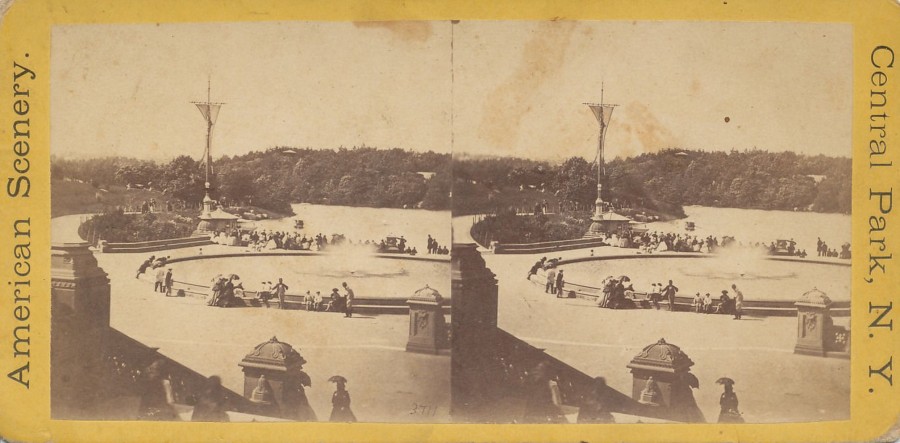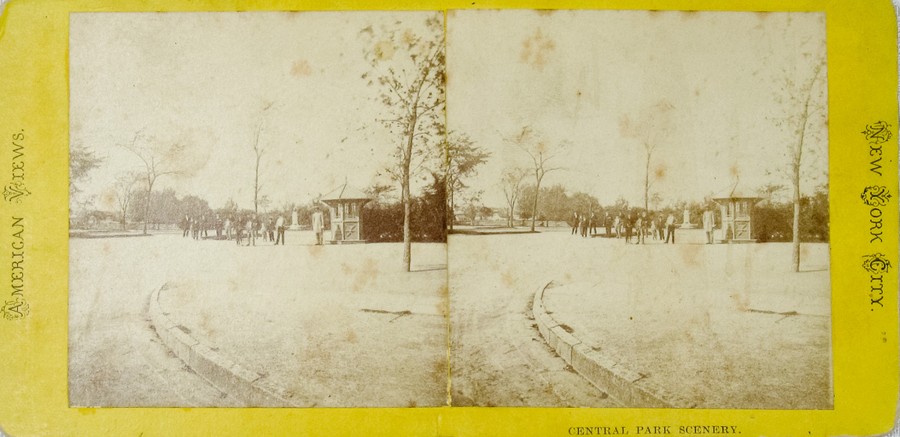20 Stereoviews Of 19th Century Central Park
Some Long Vanished Scenes And Other Familiar Sites
Central Park is a constantly evolving mixture of landscape, architecture, buildings and people. Engineer Egbert Viele first surveyed the space encompassing the park. Landscape architects Frederick Law Olmsted and Calvert Vaux, won the competition to design the park and construction started in 1858.
Over the last 150 plus years, the park has seen many additions and subtractions within it.
The 19th century version of Central Park has many things that a New Yorker today would find familiar and others that seem completely out of character; such as a convent located in the northern part of the park.
The Academy of Mount St. Vincent shown above in the 1860’s was a group of buildings which predated the park and contained a school and convent run by the Roman Catholic Sisters. The nuns left the buildings before construction started on the park and moved to Riverdale in the Bronx in 1857. The buildings they left behind remained for other uses such as a museum, storage and a rare plant conservatory. All the structures were destroyed by fire on January 2, 1881. The site of Mount St. Vincent at East 103rd Street is now the composting area for the park.
Here are some other views of Central Park from 1863-1896. Click on images to vastly enlarge.
 Bethesda Fountain before sculptor Emma Stebbins famous bronze statue Angel of the Waters was installed in 1873.
Bethesda Fountain before sculptor Emma Stebbins famous bronze statue Angel of the Waters was installed in 1873.
 Central Park’s original grand entrance on Fifth Avenue with policeman and guard house.
Central Park’s original grand entrance on Fifth Avenue with policeman and guard house.
 A camel in a field? No, it’s really Central Park in 1868. The camel was part of the menagerie (zoo). You paid extra to get a ride on it.
A camel in a field? No, it’s really Central Park in 1868. The camel was part of the menagerie (zoo). You paid extra to get a ride on it.
 The walkway or road to Sixth Avenue (circa 1868).
The walkway or road to Sixth Avenue (circa 1868).
 The “Casino,” not for gambling but a lady’s refreshment stand stood near east 72nd Street from 1864 until 1936 when it was demolished. A playground now occupies the site.
The “Casino,” not for gambling but a lady’s refreshment stand stood near east 72nd Street from 1864 until 1936 when it was demolished. A playground now occupies the site.
 The Tam O’ Shanter and Souter Johnnie statue, also known as Auld Lang Syne, depicts two old friends raising a glass of wine and toasting one another while a dog sits in the left hand corner observing. Auld Lang Syne was a popular sculpture situated right by the Casino. During cold weather it was put in storage at Mount St. Vincent. The fire at Mount St. Vincent in 1881 damaged an arm and a foot on the sculpture. After the statue was retrieved from the ruins of the fire, it should have been restored. Instead it was lost. No one knows where Auld Lang Syne is or even if it still exists.
The Tam O’ Shanter and Souter Johnnie statue, also known as Auld Lang Syne, depicts two old friends raising a glass of wine and toasting one another while a dog sits in the left hand corner observing. Auld Lang Syne was a popular sculpture situated right by the Casino. During cold weather it was put in storage at Mount St. Vincent. The fire at Mount St. Vincent in 1881 damaged an arm and a foot on the sculpture. After the statue was retrieved from the ruins of the fire, it should have been restored. Instead it was lost. No one knows where Auld Lang Syne is or even if it still exists.  Captioned in this stereoview as “The Museum” the building was originally the Arsenal and once again goes by that name. For a number of years the Arsenal housed the collections of The American Museum of Natural History until the museum moved to new headquarters across from Central Park between 77th and 81st Street in 1877.
Captioned in this stereoview as “The Museum” the building was originally the Arsenal and once again goes by that name. For a number of years the Arsenal housed the collections of The American Museum of Natural History until the museum moved to new headquarters across from Central Park between 77th and 81st Street in 1877.
 In 1870, looking south towards the Arsenal and the current location of the Central Park Zoo. This pathway, bridge and view remains today.
In 1870, looking south towards the Arsenal and the current location of the Central Park Zoo. This pathway, bridge and view remains today.  Three children pose on the Mall near 72nd Street. Put the kids in modern clothes and this view would be similar to a modern view of the Mall minus the vendors and street performers.
Three children pose on the Mall near 72nd Street. Put the kids in modern clothes and this view would be similar to a modern view of the Mall minus the vendors and street performers.
 The Bethesda Terrace seen here in 1868 remains one of the most photographed views of the park. There are more trees now, but this scene 147 years ago is strikingly similar to what you would see at this spot today.
The Bethesda Terrace seen here in 1868 remains one of the most photographed views of the park. There are more trees now, but this scene 147 years ago is strikingly similar to what you would see at this spot today.
 If you did not know this was taken in 1875, you might swear this view of a solitary person sitting on a bench looking at the lake and Bow Bridge was taken in 2015.
If you did not know this was taken in 1875, you might swear this view of a solitary person sitting on a bench looking at the lake and Bow Bridge was taken in 2015.
 Since the early 1860’s Bow Bridge over the lake has always attracted loving couples to gaze out over the water and take in the beautiful views of the surrounding area.
Since the early 1860’s Bow Bridge over the lake has always attracted loving couples to gaze out over the water and take in the beautiful views of the surrounding area.
 The lake had boat rentals but there was no boat house until 1874. The current Loeb Restaurant boathouse on the lake was built in 1954.
The lake had boat rentals but there was no boat house until 1874. The current Loeb Restaurant boathouse on the lake was built in 1954.
 Skating on the lake at Central Park used to be popular; it is currently forbidden. Seen here in 1896 skaters are enjoying a day on the lake with the Dakota apartments looming on the right and the Hotel Majestic (replaced by the Majestic apartments in 1930) on the left.
Skating on the lake at Central Park used to be popular; it is currently forbidden. Seen here in 1896 skaters are enjoying a day on the lake with the Dakota apartments looming on the right and the Hotel Majestic (replaced by the Majestic apartments in 1930) on the left.
 It was originally called Bennetts Bridge when built in 1863 by Calvert Vaux. Now called the Ramble Stone Arch it remains unchanged at West 77th Street near the lake. Made to look like ancient ruins, the bridge is only five feet wide and has a nine foot high underpass. A hidden feature: up until the 1920s an opening on the eastern side of the arch had steps which led to an underground cave which is now boarded up.
It was originally called Bennetts Bridge when built in 1863 by Calvert Vaux. Now called the Ramble Stone Arch it remains unchanged at West 77th Street near the lake. Made to look like ancient ruins, the bridge is only five feet wide and has a nine foot high underpass. A hidden feature: up until the 1920s an opening on the eastern side of the arch had steps which led to an underground cave which is now boarded up.
 Vine Clad Arbor seen here in 1870 still exists and is known today as the Wisteria Pergola, located mid-park at 70th Street near the Naumburg Bandshell. After falling into disrepair, It was extensively renovated in 1986.
Vine Clad Arbor seen here in 1870 still exists and is known today as the Wisteria Pergola, located mid-park at 70th Street near the Naumburg Bandshell. After falling into disrepair, It was extensively renovated in 1986.
 This stereoview of Central Park from 1863 is labeled “Baseball Day.” Though no bases, bats or balls are visible, beyond the group in the foreground, the people are standing in the formation of a baseball diamond. The exact location of this photo is unknown.
This stereoview of Central Park from 1863 is labeled “Baseball Day.” Though no bases, bats or balls are visible, beyond the group in the foreground, the people are standing in the formation of a baseball diamond. The exact location of this photo is unknown.
 Keeping the park clean has always been a challenge. This view from the mid-1870s shows a horse drawn watering cart which seemed to be an effective method.
Keeping the park clean has always been a challenge. This view from the mid-1870s shows a horse drawn watering cart which seemed to be an effective method.
 This is why the park roadways needed continual cleaning: hundreds of horse drawn vehicles traveling along the drives. Soon there may be no horse drawn carriages if Mayor De Blassio gets his way.
This is why the park roadways needed continual cleaning: hundreds of horse drawn vehicles traveling along the drives. Soon there may be no horse drawn carriages if Mayor De Blassio gets his way.





